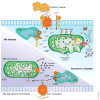Portal to Alzheimer's disease
- PMID: 18841137
- PMCID: PMC4511481
- DOI: 10.1038/nm1008-1020
Portal to Alzheimer's disease
Abstract
Genetic inactivation of the mitochondrial self-destruction mechanism improves cognition in a mouse model of Alzheimer’s disease (pages 1097–1105).
Figures

Comment on
-
Cyclophilin D deficiency attenuates mitochondrial and neuronal perturbation and ameliorates learning and memory in Alzheimer's disease.Nat Med. 2008 Oct;14(10):1097-105. doi: 10.1038/nm.1868. Epub 2008 Sep 21. Nat Med. 2008. PMID: 18806802 Free PMC article.
References
Publication types
MeSH terms
Substances
Grants and funding
LinkOut - more resources
Full Text Sources
Medical

